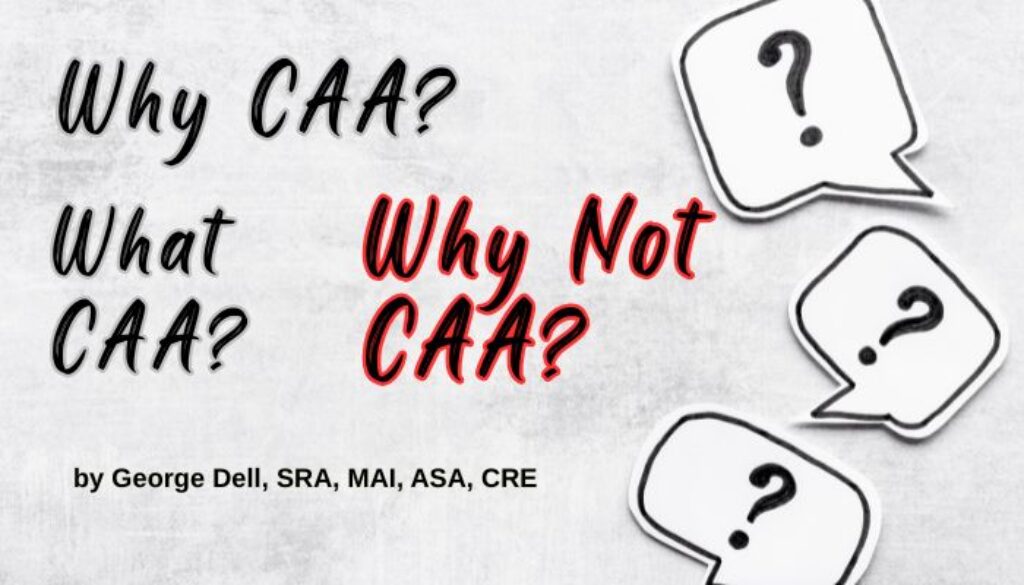The CAA was formed for a single purpose: to provide valuation professionals with a better way to serve the public trust. This, through evolved technology and contemporary knowledge of data analytics – that are based on economic principles and human behavior theory. We share open-source software solutions customized for best practices, which are evolving opportunities for appraiser’s service to clients.
Why is there a need for yet another appraiser/analyst professional group? We have the Appraisal Institute and other organizations. We have laws, regulations, standards, advisory opinions, forms software, and user forms – such as FannieMae and FreddieMac and the VA, and HUD, and Farmer Mac, and 53 state and territorial licensing and standards “enforcement” administrative agencies.
The CAA was the eventual result of a schism with the AI. Some 20 years ago, we got new education requirements, including a required class in “statistics.” The problem? The author(s) had no real practical experience in the underlying (data-centric) theory required for appraisal. Data science was almost unheard of. But everyone knew “statistics.” In school we were taught — it must be either descriptive stats, or inferential stats. Everyone knows that!
The clamor was for new “advanced” methods. It was important to look good. The methods must be clever, sophisticated, academic, and seem advanced – and therefore: clever inferential statistics.
Mistake.
Inferential statistics is based on using a random sample to represent a population. Wonderful! We can impress with hypothesis tests, t-tests, Chi-squared scores, confidence intervals, and p-values. This whole “advanced quantitative appraisal” curricula was based on the hypothetical assumed assumption of random sampling. Problem: No appraiser I have ever met picks comps at random!
In fact, the appraisal process requires exactly the opposite. We select comps very carefully. To be similar, competitive, and “able to be compared.”
The clever, sophisticated, inferential random sample statistics continue to be taught (and license-required) in appraisal education. Copy-cat educators repeat what the AI created. New appraisers must learn it, and old appraisers simply believe it to be true. No matter. Groupthink lives on and grows.
The CAA is founded on the integrity of facts and data, not acceptance of belief. Simply put — it is the science of data. Data science emphasizes data similarity, not data randomness. Data Science is the foundation needed for rational application of Artificial Intelligence (AI). Data Science is the basis for the future, not the “believe me” paradigm. “Get me some good comps” – simply does not work well with AI. Evidence-based cannot be “trust-me” based!
We have the science of data! The principles are simple:
- We have all, or substantially all, the relevant data;
- There is no need to take any kind of sample for analysis;
- Visualization of markets is very easy with the use of graphs.
- We are now able to strive for measurable reliability, not “trust me.”
The problems at the AI started long ago. The insistence on the ‘old way’ has been pervasive.
The culture first created an outmoded product, then ensured the groupthink.
As Cindy Chance affirmed, the “…next generation of diverse professionals who have found their voices, know change is urgently needed.”
The focus must be on what we sell. We must sell a better product.
We believe the profession must embrace the science of data and artificial intelligence. We integrate science and judgment, the algorithm and model. There is a need. It is our goal.
We of the CAA believe the current USPAP “worthy of belief” focus — is antithetical to today’s proper goals of valuation and risk analyses: the public trust, need for housing, investment risk analyses, and equitable government policy. Users of valuation services universally need risk/reliability results, not fixation on single-point, “worthy-of-belief’ opinions.
Join us in true analytic modernization. The Community of Asset Analysts.

May 28, 2025 @ 1:05 pm
After reading this if you agree there is a probvlem please forwad to Lyle Radke at Fannie
John M Pratt
ROV problems
I can not believe the New ROV policy that Fannie & Freddie have recently put in place. Did
someone in upper management actually read this and understand it?
You have given the Borrower, the least objective person in the whole traction and the least
knowledgeable about the appraisal process the ability to challenge the value of a residence of a
professional appraiser with years of experience and knowledge. Do you really think the
borrower knows what a comparable sale is or can define a comparable? Most appraisers won’t
change the value and if they don’t change the value, you give the borrower instruction how to
file a claim against the appraiser with the Ste Licensing Boad.
I am sure that you know that just filing a claim against an appraiser with the State Licensing
Boad can stop the appraisers stream of income and his/her ability to continue work as an
appraiser. This could be the end of a career.
Apparently, we have loss focus of what an appraisal is. It is an OPINION OF VALUE of ONE
professional, experienced appraiser. It is not right or wrong, it the appraisers OPINION, nothing
less and nothing more.
To think that a non-objective, non-trained individual could end an appraiser’s career is
unimageable and that is exactly what you have put into place. You might as well forget about
the AIR, this is clearly a violation of the intent of the AIR to protect the appraiser from influence
or an attempt to influence the conclusions of the appraiser.
John M< Pratt, Certified Residential AppraisJohn